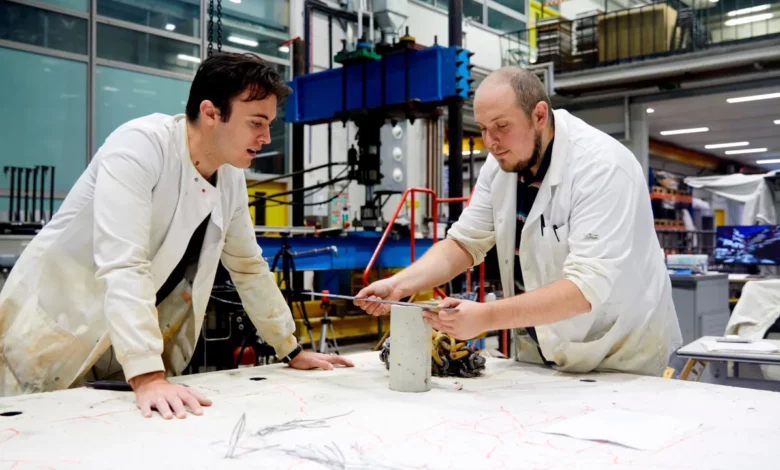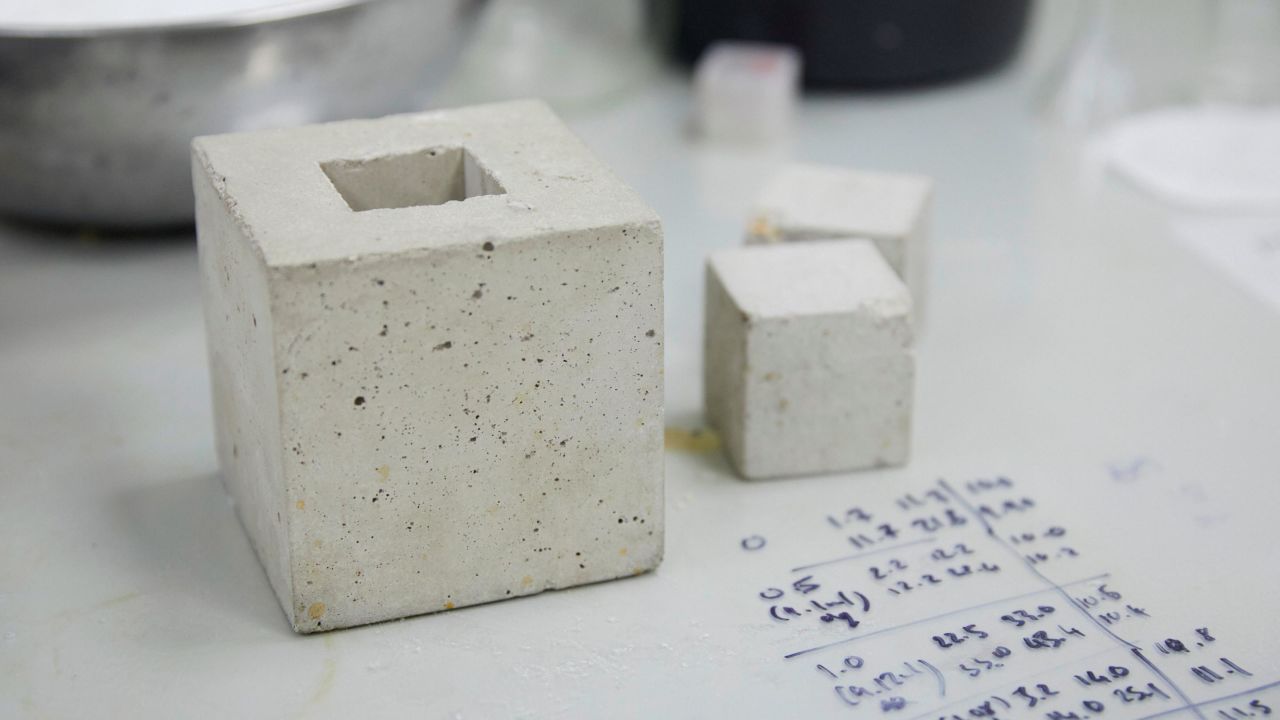
Concrete is made from water mixed with aggregates like sand and gravel, bound together by cement – and it’s the cement that is the biggest contributor to its carbon footprint.
Portland cement is the most common kind, and is produced by baking lime in a kiln. More than 4 billion tons of cement were produced in 2021, contributing 8 percent of global CO2 emissions, according to think tank Chatham House. With pressure on the construction industry to decarbonize, researchers around the world are looking for ways to make concrete greener.
“Concrete is such a fantastic, reliable material that we’re really going to struggle to cut it out everywhere,” said Sam Draper, a PhD student at Imperial College London. “We can transition to timber buildings where possible, but a lot of our infrastructure needs concrete, and to make concrete we need some sort of cement.”
Draper and fellow researcher Barney Shanks have come up with a way of making a cement that they say can produce carbon-neutral concrete.
Their process begins with a common mineral called olivine, which they split into magnesium and silica. The silica is used to directly replace 35-40 percent of the Portland cement used in concrete, while the magnesium is combined with carbon dioxide (CO2) to make magnesium carbonate, which can be then used for construction materials including alternatives to clay-fired bricks and gypsum plasterboard.
Because the CO2 used in the process can be captured from the waste flues of cement factories, which would otherwise have gone into the atmosphere, concrete made in this way is carbon neutral, says Draper, and the magnesium carbonate is a stable carbon store.
“One of the really nice things about the construction industry from a carbon sequestration perspective is that it’s big and bulky, so you can store a lot of CO2 in there,” said Draper.
“And things tend to be fairly permanent, so you’re able to get good, long-lived sequestration. Using waste CO2 to make fuels or something is nice, and it’s circular, but as soon as you burn that fuel, the CO2 is gone. The built environment gives you opportunities to really lock it in for a long time.”
After beginning their testing in 2020, Draper and Shanks launched a company called Seratech in 2021. Now, they’re just a few weeks away from formally spinning out the company from Imperial College, and being able to raise private funds for a bigger pilot facility able to produce a few tons of cement a week.

“It has to be identical”
Draper says Seratech’s cement performs as well as “gold-standard” Portland cement, adding that this is vital for its acceptance by the construction industry. “For me, this is such a driver for these low-carbon technologies,” he said. “It has to look the same, it has to feel the same … it has to be identical, or people simply won’t use it in the real world. And I’m very happy to say I think we’ve achieved that pretty well.”
Last year, the company won the Obel Award, an international prize that “promotes architecture in the service of both people and the planet.” Describing the winners, the Obel Award said: “Given the huge carbon footprint of the construction industry, Seratech’s process has the potential to significantly reduce embodied emissions globally and to support future low-carbon construction.”
Draper acknowledges that the cement is very expensive at its current research stage, but says that when scaled up, costs will be comparable with Portland cement. He adds that Seratech plans to start testing the cement in real buildings by early 2025 and hopes to have a large-scale industrial pilot by 2027, capable of supplying multiple projects.
Other startups are finding ways to store CO2 directly in concrete. CarbonCure injects captured CO2 into concrete as it’s mixed, where it reacts with cement to increase the strength of the concrete. As well as sequestering CO2, the company says this extra strength means the concrete can be made with less cement. Fellow Canadian company Carbicrete says it can replace cement entirely, by combining waste slag from steel production with carbon captured from industrial plants.
From salt water to cement
In the United Arab Emirates (UAE), researchers are working on a process to cut concrete’s carbon footprint while tackling another environmental problem.
The UAE relies on the desalination of seawater for most of its drinking water, but the process produces salt water – called brine – as a byproduct, which is pumped back into the ocean, increasing its salinity, which can harm sea life.
Kemal Celik, assistant professor of Civil and Urban Engineering at NYU Abu Dhabi, has found that the brine contains useful minerals, including high concentrations of magnesium.
“What we are doing is using this reject brine from the desalination plant and applying very simple chemistry,” he said. His team has developed a process to separate the solid and liquid components of the brine, and then use the magnesium component to make a cement.
“Magnesium-based cement is not a new type of cement … but the source of magnesium carbonates is usually from the mining industry,” explains Celik. Producing conventional magnesium-based cement requires heating and emits CO2, he says, adding that creating it from waste brine is cost-efficient and environmentally friendly.

Celik says his research is currently at the proof-of-concept stage, working with 4,000 to 5,000 liters of brine per day, but he is looking to produce the material at a big enough scale to work with the construction industry.
“I think the biggest challenge for us is the industry itself,” he explained. “The construction industry is one of the oldest industries and we might have some resistance to change the material that (it is) currently using. In that sense, we need to increase the awareness in the industry and the public.”
But Celik is determined to rise to the challenge. “As a researcher, we have to serve the community. That’s why I’m so motivated with our research that could help the world a bit in terms of fighting climate change.”
Adrian Lydon contributed to this report.




